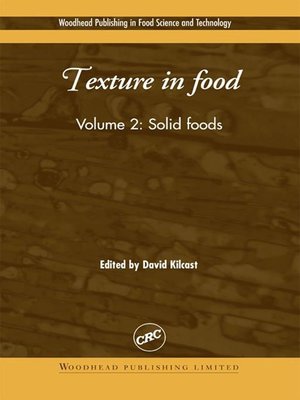Texture in Food
ebook ∣ Solid Foods · Woodhead Publishing Series in Food Science, Technology and Nutrition
By David Kilcast

Sign up to save your library
With an OverDrive account, you can save your favorite libraries for at-a-glance information about availability. Find out more about OverDrive accounts.
Find this title in Libby, the library reading app by OverDrive.



Search for a digital library with this title
Title found at these libraries:
| Loading... |
Texture is one of the most important attributes used by consumers to assess food quality. With its distinguished editor and international team of contributors, this authoritative book summarises the wealth of recent research on what influences texture in solid foods and how it can be controlled to maximise product quality.
The first part of the book reviews research on understanding how consumers experience texture when they eat, and how they perceive and describe key textural qualities such as crispness. Part two considers the instrumental techniques used for analysing texture. It includes chapters on force/deformation and sound input techniques, near infrared spectroscopy (NIR), nuclear magnetic resonance (NMR) and magnetic resonance imaging (MRI). The final part examines how the texture of particular foods may be better understood and improved. A number of chapters review ways of controlling the texture of fruits and vegetables, including the role of plant structure and compounds, the handling of raw materials and technologies such as freezing and vacuum infusion. A final group of chapters discuss the texture of cereal foods, including bread, rice, pasta and fried food.
Texture in food Volume 2: Solid foods is a standard reference for the food industry. It is accompanied by a companion volume on the texture of semi-solid foods.Reviews developments in measuring the texture of solid foods Examines the influences on texture and ways of maintaining textural properties Written by an expert team of authors
The first part of the book reviews research on understanding how consumers experience texture when they eat, and how they perceive and describe key textural qualities such as crispness. Part two considers the instrumental techniques used for analysing texture. It includes chapters on force/deformation and sound input techniques, near infrared spectroscopy (NIR), nuclear magnetic resonance (NMR) and magnetic resonance imaging (MRI). The final part examines how the texture of particular foods may be better understood and improved. A number of chapters review ways of controlling the texture of fruits and vegetables, including the role of plant structure and compounds, the handling of raw materials and technologies such as freezing and vacuum infusion. A final group of chapters discuss the texture of cereal foods, including bread, rice, pasta and fried food.
Texture in food Volume 2: Solid foods is a standard reference for the food industry. It is accompanied by a companion volume on the texture of semi-solid foods.






